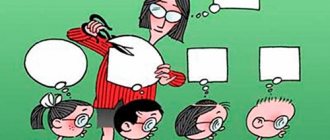Stereotypes. Windmills of our consciousness. For them, we are Don Quixote, and Sancho Panza, and just minor characters running by. Where do stereotypes come from? Why are we so strongly attached to them? Every person, in all honesty, with the proper aspiration to “cooperate with the investigation,” can find at least one stereotype in his picture of the world. After all, there are so many of them: national, gender, dynamic, religious, social - you never know how many good things have been created by the hands and minds of humanity.
People tend to think stereotypically. Relax. That is life.
National stereotypes
A great example is national stereotypes. Psychologists have long been studying the reasons why ethnic stereotypes are formed. There are quite a lot of them and not all of them are harmless:
- All Chinese and Germans are desperate workaholics
- All Russians wear earflaps, constantly play the balalaika and drink vodka.
- People from Central Asia are illiterate and ready to work for food
- All Americans are huge smiling airships dreaming of taking over the universe.
- All the English are arrogant snobs
- All Italians are sanguine
- All the French are gallant D'Artagnans
For people of a conservative mindset, especially those whose ideas about life have long been formed - all those who are outside the stable model of the ideological system are incomprehensible and alien. Even worse, the ideal ground for conflict is migration processes in society. Strangers, and even on their own territory - this visibly irritates many people. Thus, these individuals have only two ways to build relationships with strangers: either recognize them as equal, or even superior competitors in capabilities, or in every possible way discriminate against the irritating object on a distinctive and necessarily unusual basis for the discriminator. Accordingly, stereotypes and discrimination quite often accompany each other.
To be completely honest, such a time bomb is ticking in the mental structure of almost every adult individual. And that's okay! Of course, if a person knows how to reach an internal agreement and interact with his fears in a behavioral manner acceptable from the point of view of modern ethics. Flexibility of mind is not an innate property, but can be easily acquired if there is desire and motivation.
It's easy to go with the flow
Going with the flow is not so easy. Even if the current is favorable and coincides with your desires, it will still require your complete concentration and mobilization of all your strength. Energy and tenacity are needed for more than just being a rebel.
Amsterdam Navigator Freedom Trip participants were sure that there was nothing easier than going with the flow. "Fine!" - the organizers thought and decided to make the last test “easy”, that is, send the guys on river rafting. The ease turned out to be deceptive, and the last stereotype was destroyed!
Fighting stereotypes
It's no secret that today it is fashionable to fight all kinds of prejudices and stereotypes. This trend is especially pronounced in Western European countries. It is fashionable to refute the basics. It is even more fashionable to choose something exceptional, going beyond the generally accepted rules. This trend manifests itself especially clearly in issues related to morality and ethics. Who knows where all this will lead. It is quite possible that yesterday’s prejudices will turn into the norm, and stereotypes - we are on the threshold of a new milestone in the development of humanity. Clip thinking and clip standards are in themselves a kind of stereotype elevated to absolute dogma.
Gender stereotypes
Whether to believe stereotypes or not is a personal matter for each person, but what to do if you personally are caught in the middle? Oh, it’s just incredible expanse here! Perhaps the most popular stereotypes in Russia are gender roles, both in the family and in the professional field. They are so stable that more than seventy years of active construction of communism could not erase them from the Slavophile heads. Even worse, the post-war Soviet economy was literally restored from the ashes in just a few years. And all this in conditions of total gender imbalance!
Today, if you are not too lazy, you will find a huge galaxy of fashion trends and orthodox worldviews that designate a woman’s place in the family and society. Yes, these are well-known Islamists, Slavists - Domostroevtsy (Rodnovers like them). This concerns everyday aspects and family relationships. Things are much more interesting with the so-called gender criteria for professional suitability. In this case, both women and men risk being given away. Everyone has probably heard the bearded joke about a cat programmer and a vacancy in a circus. But discrimination against men working in “female” professions is much less common, but it also happens.
By the way, all of the above is happening in a country where 85% of the population grew up in a same-sex family (mother and grandmother, what are you talking about?). It would seem like a reliable vaccination against any stereotypes. But no, the trend of recent years has been collections of bearded boys, speaking with pathos about the role of women in the family, society, business and even art.
About stereotypes: from history to modernity
Andreeva S.M.
Candidate of Pedagogical Sciences
Belgorod State Institute of Arts and Culture
The concept of a picture of the world, including a linguistic one, is based on the study of human ideas about the world. The picture of the world is the result of processing information about the environment and people. The linguistic picture of the world shapes the type of person’s relationship to the world. It sets the norms of human behavior in the world, determines his attitude to reality. The processes of verbal communication, in turn, gradually lead to the development of specially motivated signs of culture [Tarasov, 1977: 90-91], which in their totality demonstrate the norms of speech interaction (according to Yu. Skrebnev, the social optimum is expressed in the norms of speech). In this regard, in the speech life of native speakers, stable speech and speech-behavioral patterns for repeated situations, or cultural stereotypes (a certain fragment of the conceptual picture of the world, a mental “picture”, a stable cultural-national idea of an object or situation) are formed. Communication norms are spread and adopted precisely through the demonstration and assimilation of these patterns [Tarasov, 1994: 111]. Consequently, different peoples live in a world of stereotypes imposed on us by the corresponding picture of the world.
It should be noted that each cultural stereotype is a complex combination of social and individual, consecrated by national tradition as a socially favorable, harmonizing speech action or speech means. Fixation to a typical situation and a certain custom ensures the stability of cultural stereotypes, the individual way of using them provides extensive variability, the ability to reflect the nuances of the situation, as well as the social and psychological characteristics of the speaker.
The term “stereotype” (Greek stereos – solid, typos – imprint) was introduced into scientific circulation by the American sociologist W. Lippman. In the book “Public Opinion,” published in 1922, he made an attempt to determine the place and role of stereotypes in the system of public opinion. By stereotype, Lippmann understood a special form of perception of the surrounding world, which has a certain influence on the data of our senses before this data reaches our consciousness [cit. by Lippman W. Public Opinion. NY,1950: 95; 23]. According to Lippmann, a person, trying to comprehend the world around him in all its inconsistency, creates a “picture in his head” regarding those phenomena that he has not directly observed.
However, there is still no single definition of stereotypes among researchers: attempts are being made to identify ways of forming and disseminating national stereotypes in society, and the issue of their influence on relations between peoples is being discussed. There is no consensus among researchers regarding the legality of using the word “stereotype” itself. In the scientific literature you can find various terms - national stereotypes, ethnic prejudices, ethnic ideas, national images and others, expressing the same phenomenon. National stereotypes are studied in various sciences - sociology, psychology, political science, philology, history. In some countries, there is an independent interdisciplinary direction that studies the origin, functioning, and influence of stereotypical ideas on the state of society. This direction was called “imagology” (in French) or “imaginology” (in English).
Stereotypes allow a person to form an idea of the world as a whole, to go beyond his narrow social, geographical and political environment. A person has a clear idea of most things even before he directly encounters them in life. Such stereotypical ideas are formed under the influence of the cultural environment of a given individual: “In most cases, we do not first see and then give a definition, we first define this or that phenomenon for ourselves, and then we observe it. In all the... confusion of the external world, we pick up what our culture imposes on us, and we have an obvious tendency to perceive this information in the form of stereotypes" [op. by Lippman W. Public Opinion. NY,1950: 81].
Stereotypes are so persistently passed on from generation to generation that they are often perceived as a given, a reality, a biological fact. If personal experience contradicts the stereotype, most often one of two things happens: the person is inflexible, uninterested for some reason in changing his views, or simply does not notice this contradiction, or considers it the exception that confirms the rule, and usually simply forgets about it. A receptive, inquisitive person, when a stereotype collides with reality, changes his perception of the world around him. Lippman does not consider stereotypes to be clearly false ideas. In his opinion, a stereotype can be true, or partially true, or false. Lippman not only introduced the term “stereotype” into scientific circulation and gave it a definition, but also emphasized the importance of this phenomenon. “The system of stereotypes,” he wrote, “is perhaps the core of our personal tradition, it protects our place in society, ... and also saves time in our busy lives and helps us escape from the bewildering attempts to see the world as stable and to grasp it completely ". With this understanding of the stereotype, two of its important features stand out - being determined by culture and being a means of saving labor effort, and, accordingly, linguistic means. If algorithms for solving mathematical problems save a person’s thinking, then stereotypes “save” the personality itself.
In the 20-30s. In America, a number of original works appeared, mainly devoted to problems of public opinion, continuing the development of the theory of stereotypes. Thus, sociologist R. Binkley calls the stereotype “the greatest common denominator” [cit. by Binkley Robert C. The Common Concept of Public Opinion in the Social Sciences // Social Forces.1928.Vol.6: 393; ibid., p.96]. According to the scientist, the presence of stereotypes allows the average person to adequately assess a political situation that is too complex for his analysis and too distant from his sphere of activity. Another work, published in the late 30s, examines the two worlds in which every person lives. One of them - the “external world” - includes what happens to us, what we ourselves saw, felt, and assessed. This world is small. We receive most of the knowledge about the world from various sources through language, which forms the so-called “verbal world”. The relationship between these worlds is the same as between a map and the real territory it represents.
If Lippman laid the theoretical foundations for the study of stereotypes, then the American scientists D. Katz and K. Braley in 1933 developed a methodology that subsequently became widespread and for many years became defining for researchers of national stereotypes.
The Second World War gave new impetus to the study of stereotypes. It clearly showed what a big role traditional, stable ideas of peoples about each other play, and how important it is to study the ways of formation (and, consequently, influence) of such ideas.
Since the late 40s. There is a new wave of interest in the study of stereotypes. Thus, at the initiative of UNESCO, a large-scale study was conducted to identify how representatives of one country perceive the people of other countries; what factors determine their perception. The UNESCO survey was conducted in the following countries: Australia, England, Germany, France, Italy, the Netherlands, Norway, and the USA. Survey participants were asked to choose from 13 definitions those that, in their opinion, characterize Russians, Americans, British, French, Chinese and themselves. The difference between positive and negative responses determined the so-called “friendliness denominator” [cit. after Buchanan W., Cantril H. How Nations See Each Other, Urbana, 1953: 97].
In Russia, the problems of studying stereotypes have not received as much attention as in the West. At the same time, a number of interesting and original concepts have been developed in our country. The concept of N.A. seems interesting and scientifically substantiated. Erofeev, which is based on historical material. Prefacing the study on the perception of England in Russia in 1825-1853 with a theoretical chapter, the author, although he refuses the term “stereotype,” pays considerable attention to the problems of perception of one nation by another.
Among the variety of problems arising from the definition of the concept “stereotype”, one can highlight a number of the most important and at the same time controversial ones, which were and are of undoubted interest for a researcher dealing with stereotypes.
One of the central problems is the presence of a grain of truth in stereotypes. There was and is not a consensus on this issue. At the everyday level, they are perceived as an objective reality. Most researchers of the problem follow Lippmann, who believed that this myth is not necessarily false. It may be completely or partially true.
Inextricably linked with the problem of clarifying the grain of truth is the question of the stability of stereotypes. If the stereotype is based on reality, then it should be relatively stable, but if it is completely and completely false, then it should change depending on the historical, international and even internal political situation in a particular country. In accordance with this position, most authors insist on the variability of stereotypes or partial variability.
Many researchers considered and still consider stereotypes to be an inevitable, but dangerous phenomenon. In their opinion, even positive stereotypes are dangerous, since they create the impression of objectivity and thus support the entire system of stereotypes as a whole. We form stereotypes to make other people's behavior more predictable. These stereotypes are often negative in nature and based on prejudice and discrimination. Stereotypes are not necessarily false; they usually contain some grain of truth.
If we analyze a stereotype as an idea based on prejudices, then through the prism of the latter we can define a stereotype as a prejudiced attitude towards someone based on his membership in a specific group or category. This implies the presence of a categorical assessment - either positive or negative, but in psychological literature we usually mean negative attitudes towards a given person or group.
In cognitive linguistics and ethnolinguistics, the term “stereotype” refers to the content side of language and culture, that is, it is understood as a mental (thinking) stereotype that correlates with the picture of the world. The linguistic picture of the world and the linguistic stereotype are correlated as part and whole, while the linguistic stereotype is understood as a judgment or several judgments relating to a specific object of the extra-linguistic world, a subjectively determined representation of an object in which descriptive and evaluative features coexist and which is the result of the interpretation of reality within socially developed cognitive models. But a linguistic stereotype can be considered not only a judgment or several judgments, but also any stable expression consisting of several words, for example, a stable comparison, cliche, etc.: gray-haired as a harrier, new Russian, white crow, etc.
According to Yu.A. Sorokin’s stereotype is a certain process and result of communication (behavior) according to certain semiotic models, the list of which is closed due to certain semiotic-technological principles accepted in a certain society. It can be assumed that stereotyping (as a result) is recognized by the individual in the form of such specific concepts as standard and norm (the generic concept in this case is the concept of stereotype), and the standard is the implementation of some semiotic and/or technological model at the social and socio-psychological levels, and the norm is the implementation of such a model at the linguistic and psychological levels.
This understanding of concepts allows us to distinguish between linguistic and non-linguistic behavior, and on the basis of this we can conclude that the standard is a non-linguistic, socio-psychological reality that exists at the linguistic level, expressed by the norm. A stereotype is a general concept that includes both a norm and a standard. A stereotype is a person’s idea of the world, formed under the influence of the cultural environment (in other words, it is a culturally determined idea), existing both in the form of a mental image and in the form of a verbal shell, a stereotype is the process and result of communication (behavior) according to certain semiotic models . A stereotype (as a generic concept) includes a standard, which is a non-linguistic reality, and a norm that exists at the linguistic level.
Stereotypes can be the characteristics of another nation, as well as everything that concerns one nation’s ideas about the culture of another nation as a whole: general concepts, norms of speech communication, behavior, categories, mental analogies, prejudices, superstitions, moral and etiquette norms, traditions , customs, etc. A stereotype is not only a mental image, but also its verbal shell, that is, stereotypes can exist at the linguistic level - in the form of a norm.
The reasons for the emergence of stereotypes are analyzed in cognitive theories, as well as within the framework of social psychology. These fields of science study the extent to which our thoughts are influenced by our immediate social context and, in turn, influence our behavior in society. Cognitive theories emphasize our need to categorize people because it simplifies the way we perceive the world around us.
It should be noted that each person has an individual personal experience, a special form of perception of the world around him, on the basis of which a so-called “picture of the world” is created in his head, which includes an objective (invariant) part and a subjective assessment of reality by the individual and the stereotype is part of this paintings.
Each language divides the world in its own way, that is, it has its own way of conceptualizing it. From this we can conclude that each language has a special picture of the world, and the linguistic personality is obliged to organize the content of the utterance in accordance with this picture. This is where the specifically human perception of the world, recorded in language, manifests itself. Language fixes collective stereotypical and standard ideas, objectifies the interpretive activity of human consciousness. Thus, the worldview of a particular people becomes the foundation of stereotypes.
LITERATURE:
1. Arutyunova N.D. Language and the human world. M., 1999.
2. Baburin A.K. On the problem of stereotyping behavior: everyday life, event, ritual // Speech and mental stereotypes in synchrony and diachrony: Abstracts. conf. M., 1995.
3. Gasparov B. M. Language. Memory. Image: Linguistics of linguistic existence. M., 1996.
4. Urban vernacular: Problems of studying / Ed. E. A. Zemskoy and D. N. Shmeleva. M., 1984.
5. Nikolaeva T. M. Speech, communicative and mental stereotypes: sociolinguistic distribution // Language as a means of cultural translation. M., 2000.
6. Sirotinina O.B. Culture of communication // Language and communication. Saratov, 1995.
7. Sorokin P. The national question as a problem of social equality/Psychology of national intolerance. Minsk, 1998.
8. Tarasov E.F. The place of verbal communication in the communicative act // National-cultural specificity of speech behavior. M., 1977.
9. Tarasov E.F. Language and culture: methodological problems // Language - culture - ethnicity. M., 1994.
10. Binkley Robert C. The Common Concept of Public Opinion in the Social Sciences // Social Forces.1928.Vol.6p.393; p.96.
11. Buchanan W., Cantril H. How Nations See Each Other, Urbana, 1953, p. 97.
12. Lippman W. Public Opinion. NY, 1950, p.95.
Social stereotypes
Unlike others, these stereotypes are the most short-lived and easily suggestible. In fact, this is not a sore of an individual person, but of social communities, between which an individual moves in one way or another throughout his life. What are they, social stereotypes?
Here are the most typical examples:
- Rich people's children are mediocre slackers
- All old people are grumpy
- All rich people are evil and greedy
- Modern youth don’t want anything and don’t know how to do anything
- Etc.
Pros and cons of stereotypical thinking
People who are accustomed to thinking in stereotypes can live a full life, even receiving certain benefits from this feature. The main advantages of stereotypical thinking include :
- quick decision making;
- less mental fatigue when analyzing information;
- joining a certain social group.
At the same time, the tendency to think in stereotypes imposes certain limitations. Its main disadvantages include :
- wrong decisions and wrong actions;
- excessive gullibility, inability to think critically;
- inability to analyze and draw conclusions independently;
- patterned thinking hinders development.
Stereotyped thinking has more disadvantages, so it is necessary to combat it by developing the ability to think critically and objectively analyze incoming information.
Professional stereotypes
Stereotypes that are somehow related to a person’s work activity are classified as professional. The most popular among them:
- All programmers are puny nerds, always wearing glasses and crooked teeth. And yes, every programmer is simply obliged to have a great understanding not only of mathematics, but also of computer repair.
- All accountants are very principled and serious people who can add and multiply three-digit numbers in their heads.
- All politicians are corrupt
- All entrepreneurs are unscrupulous traders
- All military men are tall
- All sales people are necessarily super sociable extroverts
- All lawyers are meticulous bores who read and follow absolutely all the rules, even technical instructions for household appliances
- All artists and poets are unnecessary and unkempt slobs
- All writers love to smoke a pipe and talk about lofty matters.
In general, you already understand, continue further yourself.
In France, they prefer gourmet dishes and don’t eat fast food at all.
Previously, the French state really did not welcome the opening of fast food restaurants, but now relaxations in the laws have become acceptable. According to statistics, in recent years, the revenue of fast food restaurants is several times higher than the profit of traditional establishments.
Originally Russian question
The victim of a stereotype can be either the relay of the misconception or the receiving party, a seemingly uninterested party. It’s funny, but in the vast expanses of our vast homeland there are wandering unique ones - two in one. This often occurs among teenagers who consciously choose a socially correct profession, throwing their natural abilities and abilities into the farthest corner of the darkest ideological closet.
The drama of intrapersonal contradiction is the active imposition of one’s own self-criticism on rigid parental stereotypes. The criteria of success, correctness, relevance - in general, the phenomena are very ambiguous, and then there is external pressure. Absolutely trouble! Indeed, in the modern world, such people sooner or later wash up on their “native” shores, but how much time is wasted!?
Before it’s too late, let’s look for the answer to the notorious classic question. What to do with all this mess? What to do if, among all of the above, you found your portrait or an example from your own life?
Naturally, the very first step is awareness of the problem . The second is the creation of a new model of the world . That model that will become your guiding star, a new map with which you can achieve peace and harmony in your own soul.
And the final, final and, perhaps, the most difficult step is accepting yourself as new, on the still old map of the world . Your brain, psyche, soul and even body will need some time to adapt. A somewhat mechanical formulation, but any process of learning and adoption of innovations has a biological nature. Even in such seemingly rather abstract things. This is by no means a five-minute process. Be patient and the boundaries of your world will become wider











